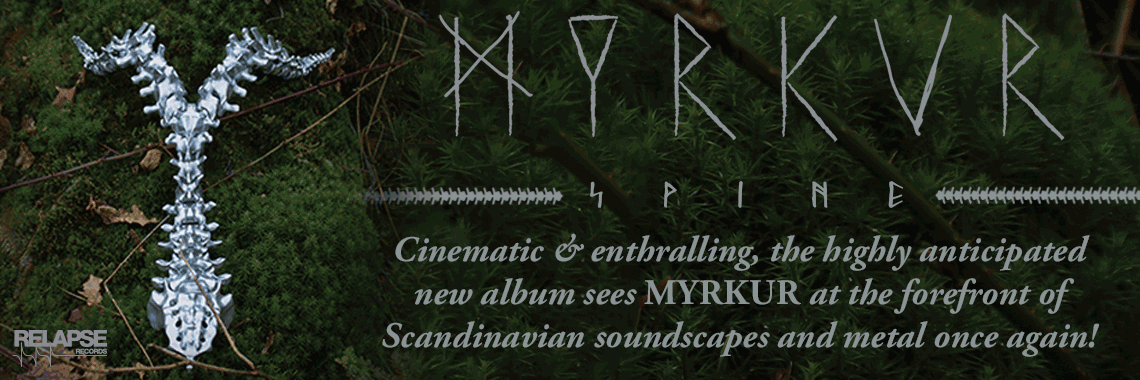
We’ve spilled plenty of ink about the new Tribulation record such that any further gushing about The Children of the Night here probably wouldn’t add anything new to the discourse. Chris Dick talked to the band for a feature in this month’s issue (more of which you can read about here) and the quartet scored the lead review and best new noise in our preceding tome. If you’ve perused either piece, however, or had the pleasure to listen to the group’s excellent third full-length, you might be interested in hearing about ten albums that helped form the entity known as Tribulation. We’ll let drummer Jakob Ljungberg take it from here.
“Some albums strike a chord in you–you hear them and are immediately spellbound, mesmerized by their pace, sound, rhythm and force. You live your life with these records and they form you as you form them into soundtracks of certain times and courses of events. I can remember where albums I’ve heard a thousand times have hit me hardest. Certain months, weeks or days listening to certain albums where the music and the mood coincide perfectly. As a band, living together and working extremely close during intense periods of time, the same things happen, and though the reflections and experiences vary from person to person in a group, here are ten albums that have struck that chord in the collective “we”. There are albums like Don’t Break the Oath, De Mysteriis Dom Sathanas and Blessed Are the Sick that might as well have made this list, but we chose to go for the possibly less well known side of things, except for the obvious must haves such as Iron Maiden and Kiss.”
You can read more about their picks below–there’s even a bonus list of contenders–and pick up a copy of the incredible The Children of the Night here.
Deep Purple–Deep Purple In Rock (1970)
The sheer songwriting joy in tracks as “Child in Time”, the dissonance in “Hard Lovin’ Man”, the all out assault of everything from everyone in “Speed King”–this album represents the epitome, birth and true meaning of the term “grand rock”. It’s a modern classic in every sense of the word, from the pompous artwork to the thoughtful tracklist, everything just breathes well-composed rock without losing the playful edge!
Wovenhand–Mosaic (2006)
The other Wovenhand albums have never really gotten me so far, they’re sure good but they never come close to this in heaviness and despair. Elin Palmer, who accidentally shares the same birthplace as us, incorporates some Swedish folk music elements in her string arrangements, which adds the swirling beauty that the record needs. The raving frenzy of “Slota Prow – Full Armour” sums up Mosaic perfectly–it never really explodes, but the intensity under the surface threatens to blaze up at any moment.
Dissection–Reinkaos (2006)
Reinkaos is a perfect example of how to make grand rock music and turn it into some kind of extreme metal that is as stellar as stellar can be. It’s touching on what some bands had done before this but in a completely new and superior way, if you ask me. As opposed to some of those bands, it’s on the right side of the yellow goat, as Peter Stjärnvind might put it.
Jan Johansson–Jazz på svenska (1964)
This album represents a lot of things: we would have liked to put the term “Swedish folk music” as this post, but that felt too vague, so here goes the most graspable outlet of the genre we’ve found so far. Recorded in three different day long sessions between 1962 and 1964, this album captures jazz pianist Jan Johansson, father of Jens and Anders Johansson formerly in Yngwie Malmsteen’s Rising Force, interpreting some of the most classic folk music tunes from all over Sweden. When we played in Kristianstad together with Necrovation, both of us had, unknowlingly of the other band, chosen “Vallåt från Jämtland” as the intro to our respective concerts. Big confusion broke out and it ended up with them changing their intro, haha.
Kiss–Destroyer (1976)
Well, this one needs no introduction. Where In Rock feels out of control yet refined, this is calculated perfection all the way! The orchestral elements and pianos throughout the album are a huge influence to us, as are the songs and the cover. No Kiss, no corpsepaint. That’s to exaggerate things I guess, but the impact ’70s Kiss has had on the contemporary rock show cannot be denied. A mighty showcase of absolute grandeur.
Bo Hansson–Mellanväsen (1975)
As far as music that ignores boundaries and rules, progressive if you want, goes this is one of the finest outlets. Beginning his solo career by interpreting The Lord of the Rings, after that Hansson teamed up with Swedish prog superstar guitarist Kenny Håkansson. Håkansson provides some of his best melodies, and hence some of the best melodies ever written, to this album. The complexity and consistency of tracks as “Lyckat Upptåg” and “Funderingar på Vinden” never seizes to amaze and inspire.
Deathspell Omega–Si monvmentvm reqvires, circvmspice (2004)
This album was spinning constantly in Arvika about 10 years ago and it’s still spinning a lot to this day. I love the sound, the songs, the vocals, the strange melodies and the over the top pretentiousness of it all. Or isn’t it over the top pretentiousness? I don’t care. This along with any other music that is worth listening to over and over makes me travel to a different place and a different time, it elevates the spirit. Sola fide. Sola Deo, Infernali Gloria!
Iron Maiden–Dance Of Death (2003)
There’s always the argument of which is the most important Iron Maiden album, and I can’t disagree with any suggestion really. They’re all relevant for their time and age and none of them are out of place or excessive. But for us to shine a light on the importance of later Maiden albums, post-Blaze Bayley, feels like an important matter of business. Iron Maiden didn’t die with Bruce leaving the band the first time, and they’re certainly not dead at the point of Dance of Death, or yet at all for that matter. Get well Bruce!
Popol Vuh–Nosferatu (1978)
Soundtracks have always been a major influence in the Tribulation camp. And as far as soundtracks go, this is one of the peaks. To capture by sound this story, this bleak pestilence ridden emptiness and the grey German medieval times feels like an impossible task, yet an obvious and absolutely natural habitat for Popol Vuh. Ambience, melodies and mood. It’s all there, and it’s all made to perfection.
Mortuary Drape–Tolling 13 Knell (2000)
Both Mortuary Drape albums up until this one have had a major impact on me—All the Witches Dance and the Mourn Path EP in particular—but the weirdness, complexity, beauty and darkness on this one made the most permanent impression on Tribulation. The wonderful clean howls (or whatever you wanna call it) on “Laylah” and “The Last Supper” are just mind blowing and really takes you into another realm. Truly one of the most original metal albums out there (two basses anyone?!).
Contenders:
- Type O Negative–World Coming Down (1999)
- The Doors–The Doors (1967)
- Goblin–Suspiria OST (1977)
- Master’s Hammer–Ritual (1991)
- Rainbow–Rising (1976)
- Dio–The Last In Line (1984)
- Funeral Mist–Salvation (2003)
- Watain–Casus Luciferi (2003)
- Monumentum–In Absentia Christi (1995)
Pick up a copy of The Children of the Night here







